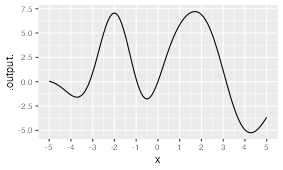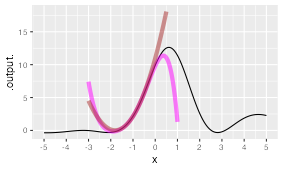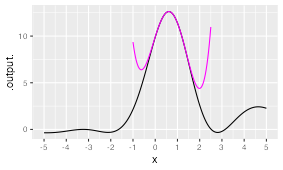question id: poly-91-1
Chap 27 Review
\[ \newcommand{\dnorm}{\text{dnorm}} \newcommand{\pnorm}{\text{pnorm}} \newcommand{\recip}{\text{recip}} \]
Exercise 1 Refer to Figure 1 when answering the following questions:

- Consider Figure 1 In the Taylor polynomial approximation to \(f(x)\) centered at \(x=-2\), what will be the sign of the coefficient on the first-order term. Choose the best answer.
Note, you can hover over the link Figure 1 to the figure to pop it up for reference.
- Consider Figure 1. In the Taylor polynomial approximation to \(f(x)\) centered at \(x=1\), what will be the sign of the coefficient on the first-order term. Choose the best answer.
question id: poly-91-2
- Consider Figure 1. In the Taylor polynomial approximation to \(f(x)\) centered at \(x=1\), what will be the sign of the coefficient on the second-order term. Choose the best answer.
question id: poly-91-3
- Consider Figure 1 In the Taylor polynomial approximation to \(f(x)\) centered at \(x=-4\), what will be the sign of the coefficient on the first-order term. Choose the best answer.
question id: poly-91-4
- Consider Figure 1 In the Taylor polynomial approximation to \(f(x)\) centered at \(x=4\), what will be the sign of the coefficient on the second-order term. Choose the best answer.
question id: poly-91-5
- Consider Figure 1 In the Taylor polynomial approximation to \(f(x)\) centered at \(x=4\), what will be the sign of the coefficient on the constant (zeroth-order) term. Choose the best answer.
question id: poly-91-6
- Consider Figure 1 In the Taylor polynomial approximation to \(f(x)\) centered at \(x=3\), what will be the sign of the coefficient on the second-order term. Choose the best answer.
question id: poly-91-7
8, Consider Figure 1. In the Taylor polynomial approximation to \(f(x)\) centered at \(x=0\), what will be the sign of the coefficient on the reciprocal term. Choose the best answer.
question id: poly-91-8
Exercise 2

Consider Figure 2. Two Taylor polynomials centered on the same \(x\) are shown. One is fifth-order, the other is third-order. Which is which?
The third-order polynomial is brown.
The third-order polynomial is magenta.
question id: drill-Polynomials-12
Exercise 3

Consider Figure 3 which includes a Taylor polynomial shown in magenta. What is the order of the polynomial?
question id: drill-Polynomials-13